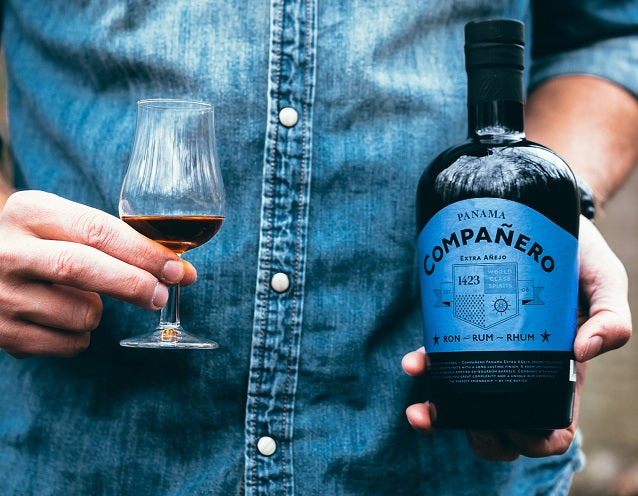Rum: History and Comparison of Light, Dark, and Spiced Rum
Posted by BERNADETTE PAMPLIN

Defined: What is Rum
Let’s start with the basics. What is rum? In its simplest explanation, rum is a distilled liquor made from sugarcane and its byproducts. Many rums are made from molasses. Molasses is the residue left after sugarcane has been liquified and then crystalised into the kind of sugar you may stir into a cup of tea or coffee.
Location depicts style, with rums from Cuba and Puerto Rico generally having light characteristics, and rums from Jamaica being richer and with rounded, full-bodied flavours. There is also Rhum, or rhum agricole, made from the liquified sugarcane. In some instances in the modern UK rum scene, it is impossible to transport wet sugarcane juice to the UK in time for it to stay fresh, so some distilleries may use a granulated version which they then liquify.
Rum is renowned for its amazing flavour. Typical notes can include vanilla, cinnamon, coffee and tobacco. The sugar necessary for fermentation is already present in the raw material. Therefore, rum retains more of its original raw material taste than other spirits. The character of each rum is defined by what yeast is used for fermentation, conditions of distillation, how it’s aged (what type of barrel and how long) and blending, a technique mixing different rums to produce a final product1.
Making Rum
Rum is a distilled spirit. To begin, the raw material must be fermented. Traditionally, the material would have been left in an open vat with yeast in the air reacting with the sugars, which trigger fermentation. As you can imagine, this left openings for each batch to be very different. Nowadays, distillers buy particular strains of yeast for consistency. Once fermented, the liquid is distilled to remove impurities.
There are two different types of still commonly used to distil rum, pot stills and column stills. Pot stills are the traditional stills for rum distillation taken to the Caribbean by Europeans. They are still seen as a way to achieve the most desirable spirit, but also have issues with consistency in the outcome of each and making large batches.

Image: Montanya Rum Distillery
Column stills (also known as Coffey or continuous stills), were patented by Aenaes Coffey in 1830 (there were previous stills invented of a similar nature, but this one was the complete, fully working design). Column stills comprise two columns that work together. The first (or analyzer) is made of layers, through which steam rises and wash falls. The second column (the rectifier) carries the alcohol and condenses it.
As the name suggests, the column still can be used continuously, with a feed of wash that can be topped up at any point. This makes for great time efficiency in the process. As a rule, pot stills produce spirits with rich flavours and more congeners, whereas column stills produce purer, cleaner distillates.
Rum's History from Slavery to Sailing
Rum style drinks go back many years. Records date as far back as 7AD2. Between then and now, there have been various drinks of this nature enjoyed around the world. The first distillation of rum in the Caribbean, the rum we know today, was in the 17th century. However, there was also rum production happening in Brazil. After a growth in popularity in Caribbean rum, the first distillery in the British Colonies of North America was set up in Boston in 1664.

It is important to note how rum played a part in the slave trade. Slaves taken from Africa were traded to the West Indies for molasses, the molasses was made into rum in New England and then that rum was traded for slaves. Early aliases for rum in the West Indies were ‘kill devil’, or ‘rumbullion’, and we undestand why.
British sailors received a regular rum ration from the 18th century until 1970. Living in Portsmouth, home of the HMS Victory, I can confirm that the Navy still observes ‘Black Tot Day’ on the 31st July, the day the rum ration ended—a sad day for many a rum drinking officer!
Types of Rum
Whereas rum used to be defined by the simple categories of: Light, Gold and Dark, in recent years Spiced rum has become a big player in the market. Nowadays, there are curious new categories emerging, such as Botanical rum, rum distilled with additional botanicals, like gin.
Today, we'll look deeper at Light/White, Gold/Dark, and Spiced rum with the help of some of the bottles in our shop.
Light / White Rum
Light or White rum is rum in its base form. Once distilled, the rum is either unaged or aged for a short time. It is sometimes filtered and this can remove the colouring if aged. The flavour profile is sweet and subtle, much lighter than it’s aged counterpart.
Montanya Platino

Motanya is a really interesting company as, unlike a lot of rums, this one is produced in Colorado and everything used in the process is sourced from the US, including sugar cane grown in Louisiana.
Founder Karen Hoskin built her distillery in the Rocky Mountains and now ships to 44 states and 7 countries. Making rum in the Rockies may sound a little odd, but in Guatemala, mountain rum is an old tradition, with the seasonal temperature and pressure changes at altitude forcing the rum in and out of the barrels, making the ageing process more effective. They have a lot of love for their mountain home. So much so that they are now the first distillery in Colorado and the third in the US to become a certified ‘B Corporation’ - a distinction that “recognised [their] commitment to prioritising social and environmental sustainability and measuring success by more than [their] financial bottom line3.”
Since 2008, Montanya Rums have earned 24 gold, silver and double-gold medals, including “Best Rum in the World” at the World Rum Awards and “USA Rum of the Year” at the Berlin International Spirits Competition. Platino is a white rum, yet still barrel finished.
>> Shop Montanya Platino
Dark / Gold Rum
Gold or Dark rum is essentially rum that has been aged to a certain degree. A darker colour will give the impression of rum that has been aged for a longer time, although some rums have coloured added to them to achieve that effect.

The flavour profiles become richer and more flavourful as the rum is aged longer. However, this isn’t an absolute rule and depending on the spirit you may encounter lighter rums that have a lot of flavour!
Compañero Extra Anejo Panama
Compañero Extra Anejo Panama is an aged rum from, yes you guessed it, Panama! Bottled by the Danish bottler known as 1423, for its Compañero range, the 12 year old rum has an overproof at 54% and has rich notes of chocolate, cinnamon and coffee.
>>Shop Compañero Extra Anjeo Panama
Spiced Rum
Spiced rum is more of a recent category, emerging in the early 2000’s with brands like Captain Morgan’s and Sailor Jerries. With these, the extra flavour came from vanilla and lime with spice4.
There is some controversy with spiced rums being a little lesser in ABV than their aged counterparts. Legally, rums sold in the UK need to be 40% to be classified as a rum. Nonetheless, the extra flavour and softer spirit became very popular with consumers. The category exploded and I think this has had a hand in increasing the popularity of rum in the UK and the growth of the UK rum scene.
Black Tears

Black Tears is made with Cuban rum that has been blended with Cuban spices. Created by the Island Rum Company, it has a distinctive bittersweet profile which gives it some extra depth in character compared to other spiced rums. The rum is spiced with coffee and cacao, staple flavours of Cuba, and aji dulce, a distinctive flavour in Cuban cuisine. Aji means chilli pepper and dulce means sweet. It is said to be related to the habanero, but with a milder, smokey flavour.
Black Tears has an emotional element, said to celebrate the “Cuba of today” and it is inspired by the Cuban song Lagrimas Negras, which tells a story of a young woman who sobbed into a vat of rum, filling it with her sorrow.
>>Shop Black Tears
Hopefully, this will whet your appetite to learn a little more about this wonderful spirit, and enjoy a glass or two. Yo, ho, ho and a bottle of rum!
>>Shop our Rum Collection
About the Author: Bernadette Pamplin

After landing a job in a gin bar, Bernadette became obsessed with gin and sought extensive training to learn all she could about the juniper spirit. Later, she merged her passion for gin and her passion for words becoming a drinks writer. She now pens articles for publications like Gin Magazine, content for Your Drink Box and her own blog, Under The Ginfluence.
She has also served as Brand Ambassador for a large UK Gin Festival and helps organise the Craft Distilling Expo as well as speaking on its panels.
Bernadette has four years experience judging events like Gin of the Year, World Gin Awards, Spirits Business Awards, American Distilling Institute Judging of Craft Spirits, IWSC, and Gin Guide Awards. She loves trying gins, learning to distinguish flavours and how the botanicals and distillation processes create the final result. Very much "under the ginfluence," Bernadette is driven by the spirit's history, flavour and story. While gin is her speciality, she has affection for all spirits.
References
1. https://www.britannica.com/topic/rum-liquor2. https://en.wikipedia.org/wiki/Rum
3. https://www.montanyarum.com/blog
4. https://www.stevethebarman.com/post/what-is-spiced-rum
TAGS:
